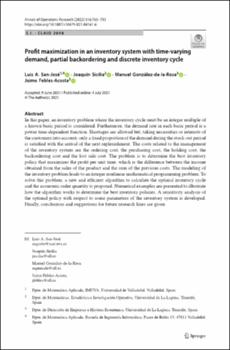Profit maximization in an inventory system with time-varying demand, partial backordering and discrete inventory cycle
Fecha
2022Resumen
In this paper, an inventory problem where the inventory cycle must be an integer multiple of
a known basic period is considered. Furthermore, the demand rate in each basic period is a
power time-dependent function. Shortages are allowed but, taking necessities or interests of
the customers into account, only a fixed proportion of the demand during the stock-out period
is satisfied with the arrival of the next replenishment. The costs related to the management
of the inventory system are the ordering cost, the purchasing cost, the holding cost, the
backordering cost and the lost sale cost. The problem is to determine the best inventory
policy that maximizes the profit per unit time, which is the difference between the income
obtained from the sales of the product and the sum of the previous costs. The modeling of
the inventory problem leads to an integer nonlinear mathematical programming problem. To
solve this problem, a new and efficient algorithm to calculate the optimal inventory cycle
and the economic order quantity is proposed. Numerical examples are presented to illustrate
how the algorithm works to determine the best inventory policies. A sensitivity analysis of
the optimal policy with respect to some parameters of the inventory system is developed.
Finally, conclusions and suggestions for future research lines are given.






